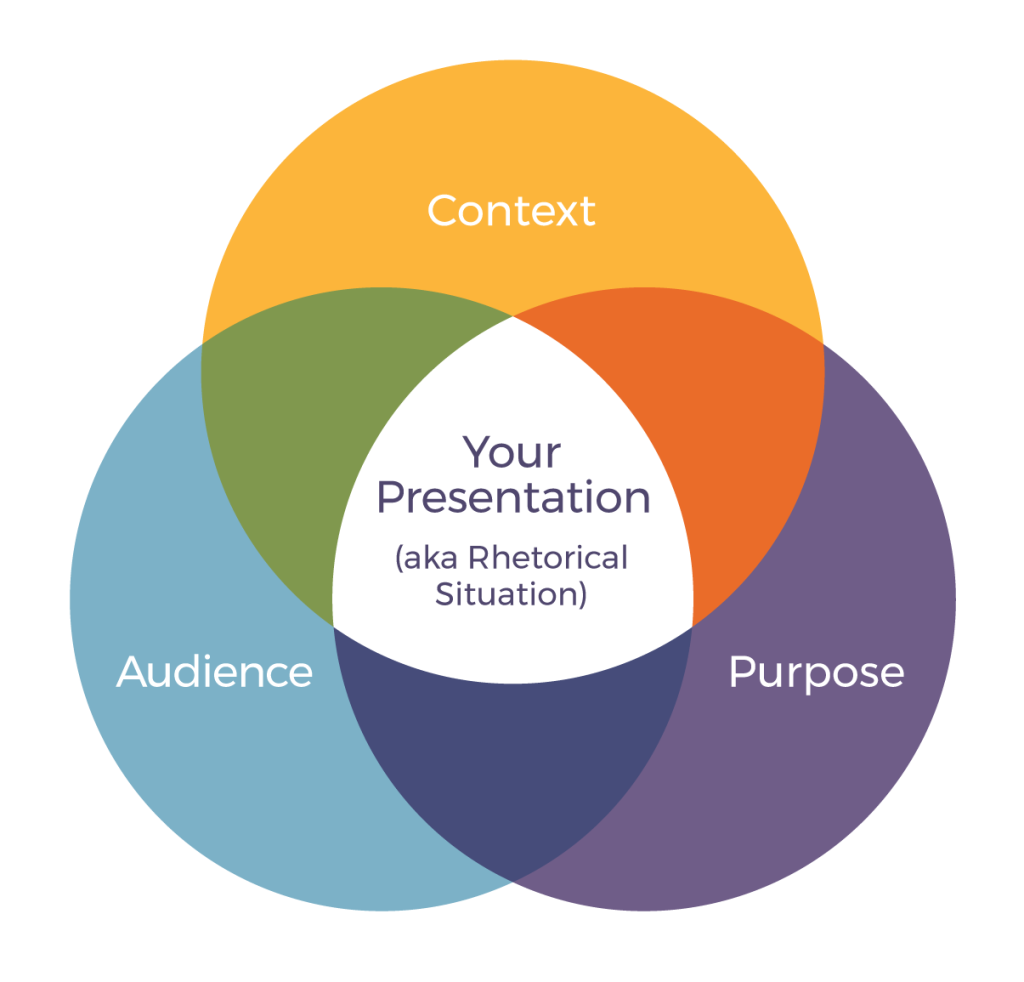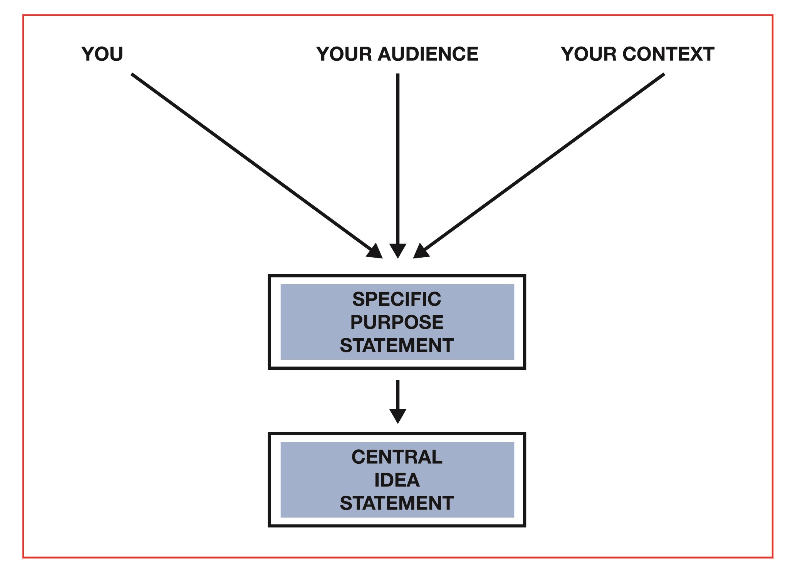11.1 – Getting Started

THE RHETORICAL SITUATION
In the classical tradition, the art of public speaking is called rhetoric; the circumstances in which you give your speech or presentation are the rhetorical situation. The audience gives you the space and time as a speaker to fulfill your role and, hopefully, their expectations. Just as a group makes a leader, an audience makes a speaker. By looking to your audience, you shift your attention from an internal focus (you) to an external (them/others) emphasis. Several of the first questions any audience member asks himself or herself are, “Why should I listen to you?” “What does what you are saying have to do with me?” and “How does this help me?” Generating interest in your speech is the first step as you guide perception through selection, organization, and interpretation of content and ways to communicate your point.
The rhetorical situation involves three elements: the set of expectations inherent in the context, audience, and the purpose of your presentation (Kostelnick & Roberts, 1998). This means you need to consider, in essence, the “who, what, where, when, why, and how” of your speech from the audience’s perspective. Figure 5.1 below demonstrates the three-part set of expectations in the rhetorical situation.

Fig. 5.1 Context, Audience, and Purpose. Your presentation depends on your knowledge of these three elements of rhetoric.
Context
Your presentation is given in a space that has connection to the rest of the world. The space you’re presenting in, the time of day, and even the events going on in the world around you and your audience will affect the decisions you make in preparing for your presentation.
Audience
The receiver (i.e., listener or audience) is one of the basic components of communication. Your audience comes to you with expectations, prior knowledge, and experience. They have a wide range of characteristics like social class, gender, age, race and ethnicity, cultural background, and language that make them unique and diverse. What kind of audience will you be speaking to? What do you know about their expectations, prior knowledge or backgrounds, and how they plan to use your information? Giving attention to this aspect of the rhetorical situation will allow you to gain insight into how to craft your message before you present it.
Purpose
A presentation may be designed to inform, demonstrate, persuade, motivate, or even entertain. The purpose of your speech is central to its formation. You should be able to state your purpose in one sentence or less, much like an effective thesis statement in an essay.
PURPOSE In Depth
Speeches have traditionally been seen to have one of three broad purposes: to inform, to persuade, and — well, to be honest, different words are used for the third kind of speech purpose: to inspire, to amuse, to please, or to entertain. These broad goals are commonly known as a speech’s general purpose, since, in general, you are trying to inform, persuade, or entertain your audience without regard to specifically what the topic will be. Perhaps you could think of them as appealing to the understanding of the audience (informative), the will or action (persuasive), and the emotion or pleasure.
Now that you know your general purpose (to inform, to persuade, or to entertain), you can start to move in the direction of the specific purpose. A specific purpose statement builds on your general purpose (to inform) and makes it more specific (as the name suggests). So if your first speech is an informative speech, your general purpose will be to inform your audience about a very specific realm of knowledge.
In writing your specific purpose statement, you will take three contributing elements (shown in figure 5.3) that will come together to help you determine your specific purpose:
- You (your interests, your background, past jobs, experience, education, major),
- Your audience
- The context or setting.
 Figure 5.3. You, your audience, and your context (Tucker & Barton, 2016)
Figure 5.3. You, your audience, and your context (Tucker & Barton, 2016)
Putting It Together
Keeping these three inputs in mind, you can begin to write a specific purpose statement, which will be the foundation for everything you say in the speech and a guide for what you do not say. This formula will help you in putting together your specific purpose statement:
To _______________ [Specific Communication Word (inform, explain, demonstrate, describe, define, persuade, convince, prove, argue)] my [Target Audience (my classmates, the members of the Social Work Club, my coworkers] __________________. [The Content (how to bake brownies, that Macs are better than PCs].
Example: The purpose of my presentation is to demonstrate for my coworkers the value of informed intercultural communication.
Formulating a Central Idea Statement
While you will not actually say your specific purpose statement during your speech, you will need to clearly state what your focus and main points are going to be. The statement that reveals your main points is commonly known as the central idea statement (or just the central idea). Just as you would create a thesis statement for an essay or research paper, the central idea statement helps focus your presentation by defining your topic, purpose, direction, angle and/or point of view. Here are two examples:
Specific Purpose – To explain to my classmates the effects of losing a pet on the elderly.
Central Idea – When elderly persons lose their animal companions, they can experience serious psychological, emotional, and physical effects.
Specific Purpose – To demonstrate to my audience the correct method for cleaning a computer keyboard.
Central Idea – Your computer keyboard needs regular cleaning to function well, and you can achieve that in four easy steps.
Media Attributions
- C5_audience
- C5_yourpresentation
- C5_PurposeStatement

